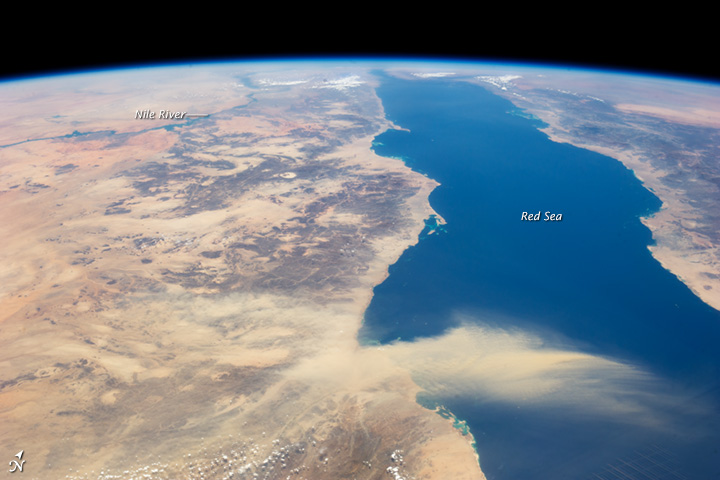This astronaut photograph provides a panoramic view of most of the length of the Red Sea, with a dust plume. It was taken on June 22, 2013 from aboard the International Space Station (ISS).
You can see the generally parallel margins of the opposing coastlines. The rift, or depression, that now holds the Red Sea has been opening slowly for about 30 million years and is nearly 300 kilometers (200 miles) wide in the region of the dust plume. The depression only began filling with seawater within the past five million years. The satisfyingly good fit between the coastlines allows you to easily visualize how Africa and Arabia were once a single landmass before the Red Sea rift formed.


The northernmost end, the Gulf of Suez, is just visible at the top center of the image and is fully 1,900 kilometers (1,200 miles) in ground distance from the International Space Station (ISS). The Nile River snakes its way northward through the Sahara Desert on the left.
Much closer to the camera—but still more than 550 kilometers (340 miles) from the ISS—is a dust plume surging out over the Red Sea and reaching most of the way to Saudi Arabia. The point source of this plume is the delta of the southern Egyptian river Khor Baraka.
This astronaut photograph was acquired on June 22, 2013, with a Nikon D3S digital camera using a 50 millimeter lens, and is provided by the ISS Crew Earth Observations experiment and Image Science & Analysis Laboratory, Johnson Space Center. The image was taken by the Expedition 36 crew.
Bottom line: This astronaut photograph of the Red Sea, taken on June 22, 2013 from aboard the International Space Station (ISS), lets you easily visualize how Africa and Arabia were once a single landmass before the Red Sea rift formed.











